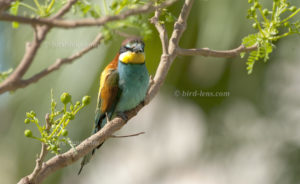 Bee-eaters (Merops apiaster): They cover thousands of kilometers between the winter quarters and the breeding area. It is summer and most migratory birds have long returned from their winter quarters. Their breeding business is in full swing. One bird species is already thinking about the return flight: Merops apiaster, the European Bee-eater. The colorful birds arrive in our latitudes only in the second half of May, and in August they are flying back to the south. In between, they still have enough time to raise their young and prepare them for the long journey to the winter quarters. It is important to cross the Sahara or the Arabian Peninsula, as the Bee-eaters winter in the dry areas of East and West Africa. Some of them are even drawn to South Africa. The colorful bee-eaters are a very popular and grateful photo motif.
Bee-eaters (Merops apiaster): They cover thousands of kilometers between the winter quarters and the breeding area. It is summer and most migratory birds have long returned from their winter quarters. Their breeding business is in full swing. One bird species is already thinking about the return flight: Merops apiaster, the European Bee-eater. The colorful birds arrive in our latitudes only in the second half of May, and in August they are flying back to the south. In between, they still have enough time to raise their young and prepare them for the long journey to the winter quarters. It is important to cross the Sahara or the Arabian Peninsula, as the Bee-eaters winter in the dry areas of East and West Africa. Some of them are even drawn to South Africa. The colorful bee-eaters are a very popular and grateful photo motif.
The breeding population surveys in recent years have shown a gratifying increase. One of the decisive factors for the positive population development in Germany is the preservation of habitats. Because we have literally built away their original nesting sites on natural river banks, European Bee-eaters today largely rely on anthropogenic breeding sites such as sand pits and ravines. The breeding population surveys show that, in 2000, there were only a few couples, e.g. in the Upper Rhine Valley. The last years there were already 100 couples. A pleasing record and yet only a small step in the right direction – especially since the reasons for the new increase in the population have not yet been fully understood. This may be due to increasing global warming or natural population fluctuations.
However, closer scientific considerations show that even with this species, a clear, but not necessarily exclusive, climate effect can be assumed to explain the current area expansion to the north. Possible causes for the increasing occurrence of the bee-eater could be:
- Weather: Warm air cells entering Central Europe during the breeding season obviously meet the sociable migrating Bee-eater with its tendency to prolong migration paths.
- Climate opportunism: A comparatively weak breeding site loyalty and the ability for spontaneous episodic breeding settlements after warm winters and in years with early summer temperatures promote settlement speed.
- Food: It can be assumed that warm winters and early summer temperatures have a positive effect on the development of large insects.
- Brood sites: After extensive loss of suitable sandbanks, mechanical sand and gravel mining now provide a sufficient number of secondary habitats as breeding sites.
- Direct persecution: A high level of awareness of the species’ protection status reduces the persecution of the species as a competitor (beekeeper) and through trophy collectors
It can be seen that changes in agriculture such as increased fallow land, organic farming or alternative crops could also have a positive impact on the population. However, this positive population development in Germany can only continue if appropriate measures are taken to preserve the remaining habitat for the bee-eater. The bird is still one of the endangered species in this country.
Because of its food spectrum, the bee-eater relies on a warm climate. Over the centuries the bird has continued to expand its area to the north. But it is an eventful story of expansion and withdrawal. The Bee-eater is currently on the rise again, breeding pairs have even been observed in Denmark. In Baden-Württemberg, the area around the sunny Kaiserstuhl with its loess soils offers the best conditions. As I said, around 100 pairs breed on the Upper Rhine today.
In order to meet the growing demand for top images of the rarer species of Palaearctic Bird-lens.com has specifically made trips to remote places. Additionally every chance is used, if a rare bird is around the homeground. This to do everything to ensure excellent photos of the Birds of the Western Palearctic . The yield of pictures also of rare Western Palaearctic birds is very good, as you can see with the picture of the blog. Other nice images of birds you will find behind the tab “Picture Shop“. Just give a notice if you need a picture of a bird which is not online.
A brilliant article as I try to gauge the potential of regular breeding Bee-eaters in the UK. The average nesting site in the UK is with Sand Martins. They can add protection to nests as well as aiding the Bee-eaters to easy dug nest sites. But a recent one in 2022 was in a disused quarry on a sloping face not 90′ and easy access from predators. Still 6 young were reared from 2 nests. One question – Are Bee-eaters having reduced success in their normal range due to climate change?
Hi John, I did not read any article concerning breeding success impacts by climate change. Sorry!